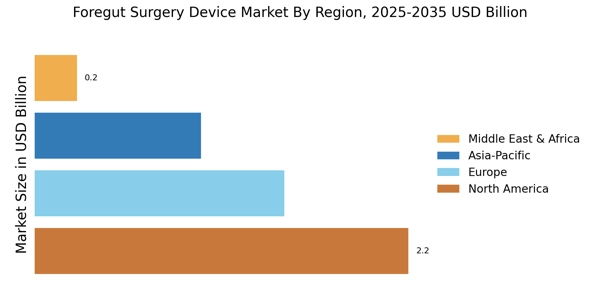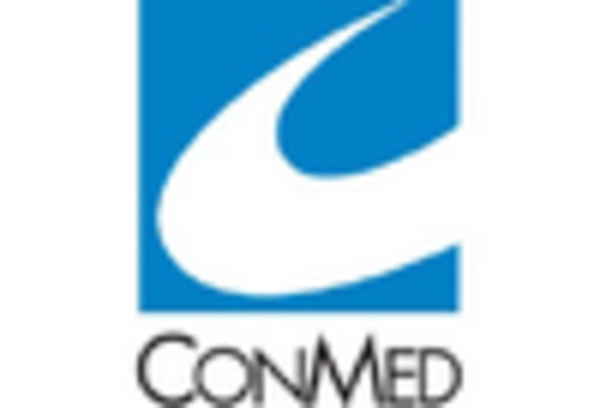Minimally Invasive Techniques
Minimally invasive techniques are transforming the Foregut Surgery Device Market by offering patients less traumatic options for surgical intervention. These techniques, which include laparoscopic and endoscopic procedures, are associated with reduced postoperative pain and shorter hospital stays. Data suggests that the market for minimally invasive surgical devices is projected to grow at a compound annual growth rate of 12% over the next five years. This growth is driven by an increasing preference among surgeons and patients for procedures that minimize scarring and recovery time. Additionally, the rising awareness of the benefits of minimally invasive surgery is likely to further propel the demand for specialized foregut surgery devices. As healthcare providers continue to adopt these techniques, the Foregut Surgery Device Market is expected to expand significantly, reflecting a broader trend towards patient-centered care.
Rising Demand for Gastrointestinal Treatments
The Foregut Surgery Device Market is witnessing a notable increase in the demand for gastrointestinal treatments, driven by a growing prevalence of digestive disorders. Conditions such as gastroesophageal reflux disease (GERD) and obesity are becoming more common, necessitating effective surgical interventions. Recent statistics indicate that the incidence of GERD has risen by approximately 20% in the last decade, leading to a corresponding increase in the need for foregut surgical devices. This rising demand is further fueled by an aging population, which is more susceptible to gastrointestinal issues. As healthcare systems strive to address these challenges, the market for foregut surgery devices is likely to expand, reflecting the urgent need for innovative solutions in gastrointestinal care. The convergence of these factors suggests a robust growth trajectory for the Foregut Surgery Device Market in the coming years.
Increased Investment in Healthcare Infrastructure
The Foregut Surgery Device Market is benefiting from increased investment in healthcare infrastructure across various regions. Governments and private entities are allocating substantial resources to enhance surgical facilities and acquire advanced medical technologies. This investment is particularly evident in developing regions, where the establishment of specialized surgical centers is on the rise. Enhanced infrastructure not only improves access to surgical care but also facilitates the adoption of cutting-edge foregut surgery devices. As healthcare systems evolve, the demand for high-quality surgical interventions is expected to grow, thereby driving the market for foregut surgery devices. Furthermore, the establishment of training programs for healthcare professionals in these regions is likely to ensure the effective use of advanced technologies, further propelling the Foregut Surgery Device Market.
Growing Awareness and Education on Surgical Options
The Foregut Surgery Device Market is experiencing growth due to increasing awareness and education regarding surgical options among patients and healthcare providers. Educational initiatives aimed at informing patients about the benefits and risks of foregut surgeries are becoming more prevalent. This heightened awareness is leading to more informed decision-making and a greater willingness to pursue surgical interventions. Data indicates that patient engagement in healthcare decisions has risen significantly, with more individuals seeking information about their treatment options. As patients become more knowledgeable about the advantages of advanced foregut surgery devices, the demand for these technologies is likely to increase. Additionally, healthcare providers are also becoming more adept at discussing surgical options, which may further enhance the growth of the Foregut Surgery Device Market.
Technological Advancements in Foregut Surgery Devices
The Foregut Surgery Device Market is experiencing a surge in technological advancements that enhance surgical outcomes. Innovations such as robotic-assisted surgery and advanced imaging techniques are becoming increasingly prevalent. These technologies not only improve precision but also reduce recovery times for patients. According to recent data, the adoption of robotic systems in foregut surgeries has increased by approximately 30% over the past few years. This trend indicates a shift towards more sophisticated surgical methods, which are likely to drive the demand for advanced foregut surgery devices. Furthermore, the integration of artificial intelligence in surgical planning and execution is expected to revolutionize the field, making procedures safer and more efficient. As these technologies continue to evolve, they are anticipated to play a pivotal role in shaping the future of the Foregut Surgery Device Market.


















Leave a Comment